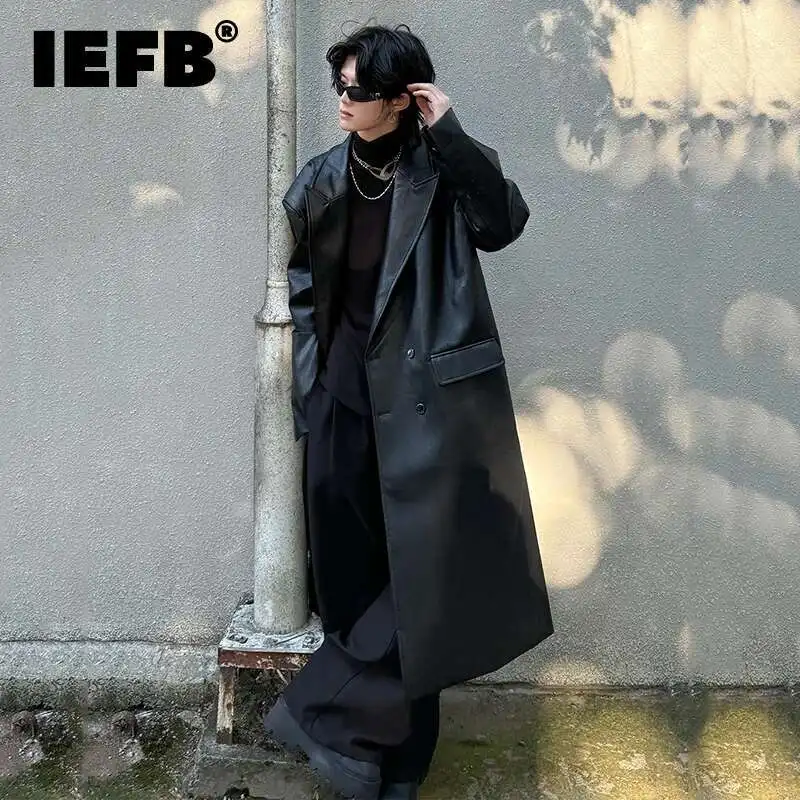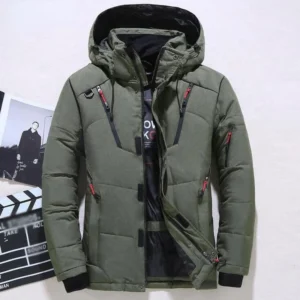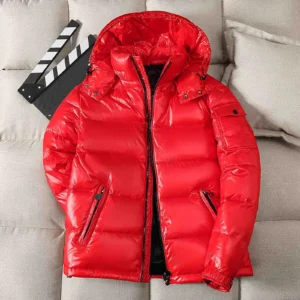Understanding Coat Styles and Their Fundamental Differences
When exploring the world of men’s outerwear, two distinct styles stand prominently: single-breasted and double-breasted coats. The difference between these two classic designs goes far beyond mere aesthetics, influencing everything from your silhouette to the occasions where each coat shines.
At its core, a single-breasted coat features a single vertical column of buttons with a narrow overlap of fabric at the front closure. By contrast, a double-breasted coat showcases two parallel rows of buttons with a significant overlap of fabric, creating a distinctive wrapped appearance across the torso.
These fundamental differences create two entirely different coat experiences:
- Visual Structure: Single-breasted coats present a cleaner, more streamlined appearance while double-breasted versions create a bolder, more commanding presence
- Front Coverage: Double-breasted designs provide additional chest coverage through their wider front overlap
- Formality Perception: Traditionally, double-breasted coats convey a more formal, distinguished character compared to their single-breasted counterparts
The heritage of these styles runs deep through menswear history, with both designs evolving from military uniforms to become staples of refined civilian attire. Today, Metro Cloak continues this legacy by crafting both styles with meticulous attention to detail and premium materials.
Throughout this guide, we’ll explore these two classic coat styles across multiple dimensions—from their construction and visual impact to styling options and practical considerations—helping you make an informed choice that aligns with your personal style and needs. The ultimate guide to men’s double-breasted coats provides context for our comprehensive discussion of coat styles.
The Anatomy of a Single-Breasted Coat
The single-breasted coat represents a cornerstone of men’s outerwear with its clean, versatile design. Its defining feature is a single vertical row of buttons running down the front, typically with a modest overlap of fabric that creates a streamlined appearance.
The button configuration varies across different single-breasted styles:
- One-button: Often seen on tuxedo jackets and some casual coats, creating a deep V-shape when closed
- Two-button: The most common and versatile arrangement, offering a balanced look suitable for most occasions
- Three-button: A more traditional configuration that provides greater chest coverage, popular in longer overcoats
Lapels on single-breasted coats most commonly feature notch designs—where the collar and lapel meet at a 75-90 degree angle, creating a “notch.” This classic lapel style complements the coat’s understated elegance.
The structure of a single-breasted coat emphasizes clean lines and versatility. The front panels meet with minimal overlap, allowing for ease of movement and a less formal appearance compared to double-breasted alternatives. When unbuttoned, the coat falls naturally at the sides, maintaining its shape without excess fabric.
This straightforward design creates a silhouette that works well across various body types without adding visual bulk to the chest and midsection. The simplicity also makes single-breasted coats more adaptable to different styling choices, from formal to casual contexts.
Modern wool overcoat options featuring single-breasted designs showcase the style’s enduring popularity and versatility across seasons and dress codes.
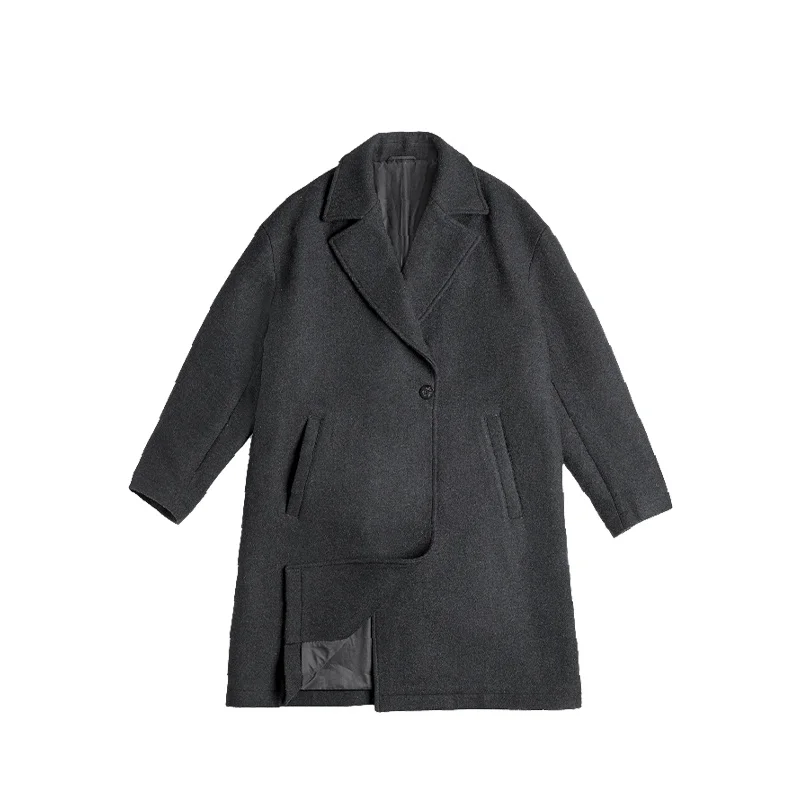
The Anatomy of a Double-Breasted Coat
The double-breasted coat immediately announces itself with distinctive parallel rows of buttons across the front—a design choice that creates both visual interest and functional benefits. This arrangement allows for substantial fabric overlap, wrapping the front panels across the chest and securing them with buttons aligned in two vertical rows.
Button configurations on double-breasted coats are typically described with two numbers:
- The first number indicates the total buttons visible on the front (commonly 6, 4, or 8)
- The second number tells you how many buttons actually fasten (usually 2 or 3)
For example, a “6×2” configuration—the most classic arrangement—features six buttons with only the middle two intended for fastening. The lower buttons on a double-breasted coat are primarily decorative, while an interior anchor button (called a “jigger”) helps maintain the coat’s shape when closed.
Peak lapels are the standard choice for double-breasted coats, with their upward-pointing tips creating a strong shoulder line that complements the coat’s commanding presence. This lapel style naturally harmonizes with the wider front overlap, creating visual balance.
The structural design of double-breasted coats involves wider front panels that wrap significantly across the torso, creating additional layers of fabric that provide both warmth and a stronger visual statement. This wrapping effect naturally creates a broader appearance through the chest and shoulders—a defining characteristic of the style’s powerful silhouette.
Understanding the advantages of double-breasted coats helps appreciate why this style has maintained its appeal through changing fashion trends. For those interested in experiencing this classic style, our selection of double-breasted overcoats offers premium examples of this sophisticated design.
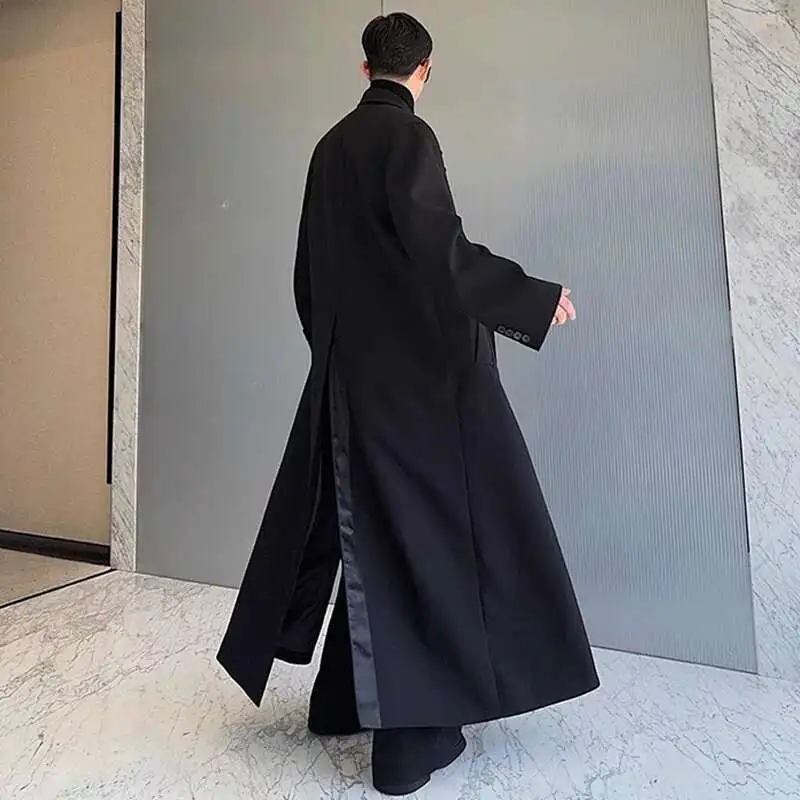
Visual Impact: Silhouette and Presence
The choice between single-breasted and double-breasted styles profoundly influences how a coat shapes your silhouette and the impression you make when entering a room.
Single-breasted coats create a clean, vertical line down the center of the body. This streamlined appearance works with your natural proportions rather than dramatically altering them. When unbuttoned, these coats hang straight down, maintaining a relaxed, effortless look that doesn’t demand attention but quietly communicates refinement.
In contrast, double-breasted coats transform your silhouette with their structured wrapping effect. The overlapping fabric across the chest naturally creates a broader, more commanding upper body shape. The horizontal lines created by the rows of buttons add visual width, while the peaked lapels draw the eye upward and outward to the shoulders, enhancing their appearance.
This difference in visual weight is significant:
- Single-breasted coats distribute visual interest evenly, creating balance without emphasis on any particular area
- Double-breasted coats concentrate visual weight in the chest and shoulders, creating a more powerful upper body impression
The shoulder structure interacts differently with each style as well. Single-breasted designs allow the natural shoulder line to remain visible, while double-breasted coats tend to enhance and slightly extend the perceived width of the shoulders through their construction and lapel design.
Length plays a crucial role too—longer double-breasted overcoats make a grand statement, while shorter versions (like peacoats) offer a more accessible approach to the style. Learning specific techniques for styling double-breasted coats effectively can help you maximize their visual impact for different occasions.
Formality Spectrum: When to Wear Each Style
Understanding where each coat style falls on the formality spectrum helps you make appropriate choices for different settings and occasions.
Traditionally, double-breasted coats have carried stronger associations with formality, authority, and special occasions. Their military heritage and the structured wrap-around design convey sophistication and deliberate elegance. Single-breasted styles, while still refined, have historically offered greater versatility across formality levels.
Today, these distinctions remain relevant but with more flexibility:
| Occasion | Single-Breasted | Double-Breasted |
|---|---|---|
| Formal Events | Appropriate with proper styling | Excellent choice, naturally formal |
| Business Settings | Standard choice, widely accepted | Makes a confident statement |
| Smart Casual | Easily dressed down | Requires more careful styling |
| Casual Outings | Works well, especially in relaxed fabrics | Can appear overdressed unless styled intentionally |
The material of the coat significantly influences its formality regardless of cut. A cashmere single-breasted coat may read more formal than a tweed double-breasted version, demonstrating how fabric choice interacts with structural design to determine overall formality.
Length also affects perception—longer coats in either style typically convey greater formality than shorter versions. This is particularly true for double-breasted designs, where full-length overcoats represent the style at its most distinguished and formal.
Metro Cloak designs coats with this spectrum in mind, offering both styles with carefully considered details that allow for appropriate wear across various settings. For those interested in formal occasions, mastering formal double-breasted coats provides valuable insights, while our formal coat options offer excellent choices for professional and special occasions.
Styling Guide: Single-Breasted Coats
The beauty of single-breasted coats lies in their remarkable versatility, allowing them to complement nearly any outfit with minimal effort. Here’s how to make the most of this adaptable style:
Business and Formal Wear:
– Pair with tailored suits in complementary or matching colors for a cohesive professional look
– Choose darker colors (navy, charcoal, black) for maximum versatility across formal settings
– Maintain proportion by ensuring the coat is slightly longer than your suit jacket
Smart Casual Styling:
– Layer over fine knitwear and dress shirts with tailored trousers for refined yet relaxed elegance
– Consider camel, light gray, or blue tones that bridge formal and casual contexts
– Use accessories like patterned scarves to add visual interest while maintaining the coat’s clean lines
Casual Applications:
– Combine with dark denim, chinos, and quality knitwear for elevated weekend attire
– Experiment with textured fabrics like tweed or herringbone for a more relaxed character
– Consider leaving the coat unbuttoned to showcase layered outfits underneath
The single-breasted coat’s adaptability extends to accessorizing as well. Scarves can be worn multiple ways—from tucked inside for a cleaner appearance to draped over for casual elegance. Gloves and hats pair effortlessly with these coats without competing with their understated design.
Button stance influences the overall look significantly. Higher button positions create a more traditional, formal appearance, while lower stances offer a contemporary, elongating effect. Most single-breasted overcoats look appropriate whether buttoned or open, giving you flexibility throughout your day.
For those building their outerwear collection, our versatile overcoats including single-breasted options provide excellent starting points for developing your personal style approach.
Styling Guide: Double-Breasted Coats
Double-breasted coats make a confident style statement that requires thoughtful pairing to achieve the right balance. Here’s how to wear this distinguished style effectively:
Formal Excellence:
– Pair with tailored suits, particularly those with similar proportions and shoulder structure
– Ensure proper buttoning—typically the middle row should be fastened, with the bottom row left unfastened
– Choose elegant accessories that match the coat’s sophistication: leather gloves, silk scarves, and structured hats
Business Refinement:
– Combine with solid-colored suits or fine knitwear and tailored trousers
– Maintain consistent color tones between your coat and inner layers for a harmonious appearance
– Consider darker, classic colors (navy, charcoal) that project authority in professional settings
Modern Casual Interpretation:
– Create contrast by pairing structured double-breasted coats with more relaxed pieces
– Try combining with quality denim, fine knitwear, and leather footwear for smart-casual settings
– Use textured fabrics like tweed or flannel to soften the formality while maintaining sophistication
Unlike single-breasted coats, double-breasted styles generally look best when properly fastened. The design is intended to create a wrapped, secure appearance—leaving it unbuttoned significantly changes the silhouette and can appear unintentionally disheveled.
Proper fit is paramount with double-breasted coats. The front overlap should lie flat without gapping or pulling, and the shoulders should align perfectly with your natural shoulder line. The coat should close comfortably without strain on the buttons, maintaining clean lines across the chest and waist.
Color choices for double-breasted coats often lean toward classic, authoritative tones that enhance their commanding presence. Navy, charcoal, and camel remain perennial favorites that maximize versatility while honoring the style’s distinguished character.
For timeless combinations that work well with these statement pieces, the classic double-breasted coat guide offers valuable insights into creating sophisticated ensembles.
Mens Heavy Winter Coat, Mens Insulated Coat, Mens Parka Coat
Price range: $175.52 through $237.36 Select options This product has multiple variants. The options may be chosen on the product pageMens Big and Tall Winter Coats, Mens Down Coat, Mens Hooded Winter Coat, Mens Puffer Coat
Price range: $126.44 through $217.01 Select options This product has multiple variants. The options may be chosen on the product pageMens Big and Tall Winter Coats, Mens Hooded Winter Coat
Price range: $80.32 through $106.68 Select options This product has multiple variants. The options may be chosen on the product pageMens Cashmere Overcoat, Mens Hooded Winter Coat, Mens Wool Blend Coat
Price range: $128.72 through $139.68 Select options This product has multiple variants. The options may be chosen on the product pageMens Hooded Winter Coat, Mens Insulated Coat, Mens Puffer Coat, Mens Quilted Coat
Price range: $139.88 through $177.72 Select options This product has multiple variants. The options may be chosen on the product pageMens Black Overcoat, Mens Black Wool Coat, Mens Wool Overcoat
$339.18 Select options This product has multiple variants. The options may be chosen on the product page
Body Type Considerations: Finding Your Best Fit
Contrary to common misconceptions, both coat styles can work for various body types when properly fitted and proportioned. Finding your ideal match depends on understanding how each style interacts with your natural build.
| Body Type | Single-Breasted Recommendations | Double-Breasted Recommendations |
|---|---|---|
| Tall & Lean | Longer lengths enhance proportion; consider 3-button styles | Creates beneficial width; 6×2 configuration balances height |
| Shorter Stature | Shorter length; minimal details; vertical emphasis | Choose shorter styles (peacoat length); 4×2 configuration reduces overwhelming effect |
| Broader Build | Structured shoulders; clean lines; darker colors | Emphasizes powerful silhouette; proper tailoring prevents excess bulk |
| Slim Build | Slightly fitted silhouette; layering-friendly | Adds visual weight to frame; creates impression of broader chest |
The key myth to debunk is that double-breasted coats only flatter certain body types. With proper tailoring, this style can work wonderfully across physiques. The crucial factor is proportion—ensuring the coat’s length, button stance, and lapel width harmonize with your natural dimensions.
Shoulder fit remains the foundation of a well-fitting coat regardless of style. The shoulder seam should align with your natural shoulder edge, allowing comfortable movement without restriction or excess fabric. From this foundation, other elements can be adjusted to optimize the coat’s appearance.
For taller individuals, longer coat lengths create balanced proportions, while shorter individuals benefit from coats that end around the mid-thigh to maintain visual balance. The expert guide to double-breasted coat fit provides detailed insights into achieving perfect proportions.
Understanding the differences between classic and slim fit styles further helps in selecting the most flattering silhouette for your particular build.
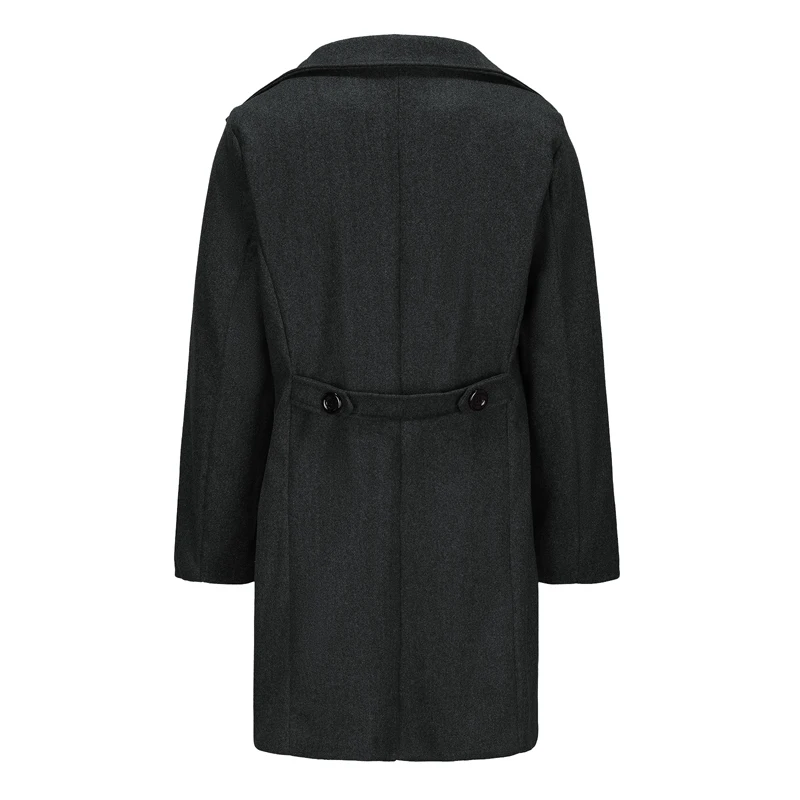
Practical Considerations: Warmth, Comfort, and Wearability
Beyond style, practical aspects significantly influence the daily experience of wearing each coat type.
Weather Protection:
– Double-breasted coats offer superior cold weather protection through their overlapping front panels, which create an additional layer of insulation across the chest
– The wrapped design naturally blocks wind more effectively at the center front
– Single-breasted designs may require an additional scarf for comparable chest protection in harsh conditions
Freedom of Movement:
– Single-breasted coats typically allow greater ease of movement with their simpler construction
– They transition smoothly between buttoned and unbuttoned states throughout the day
– Double-breasted styles tend to be designed for wearing buttoned, making them slightly less adaptable for activities requiring extensive movement
Daily Practicality:
– Single-breasted coats offer greater versatility for variable temperatures and activities
– They transition easily from outdoor to indoor settings without appearing disheveled
– Double-breasted coats make more of a committed statement and generally look best maintained in their properly buttoned state
Maintenance Requirements:
– Both styles benefit from proper hanging on shaped hangers to maintain shoulder structure
– Double-breasted coats may require more frequent pressing to maintain the clean appearance of their overlapping front panels
– The additional buttons on double-breasted coats require occasional checking to ensure secure attachment
Metro Cloak addresses these practical concerns through thoughtful design choices—using premium materials that provide warmth without bulk, engineering armholes for comfortable movement, and ensuring that construction details support long-term wearability regardless of style preference.
For those prioritizing weather protection during colder months, our selection of coats designed for optimal warmth offers excellent options in both single and double-breasted styles.
Making Your Choice: Decision Factors
When deciding between these two classic styles, consider these key factors to guide your selection:
Lifestyle Compatibility:
– Do you need maximum versatility across different settings, or are you seeking a distinctive statement piece?
– How formal are your typical daily environments and social occasions?
– Do you prefer simplicity and ease, or do you enjoy more structured, deliberate styling?
Wardrobe Integration:
– Consider your existing clothing—single-breasted coats pair easily with most wardrobes
– Double-breasted styles work best with similarly refined garments that match their level of sophistication
– Think about colors and fabrics that will complement your most frequently worn outfits
Personal Expression:
– Single-breasted coats offer understated elegance and timeless versatility
– Double-breasted styles project confidence and sartorial knowledge
– Consider which aligns better with how you wish to present yourself
For many men, the ideal solution eventually becomes owning both styles—a versatile single-breasted coat for everyday use and a distinguished double-breasted option for occasions that call for more presence. This combination provides maximum flexibility while allowing you to enjoy the unique benefits of each design.
If you’re investing in just one coat, single-breasted styles typically offer greater versatility across contexts, while double-breasted coats make a stronger impression in settings where refined style matters most. Learning when and where to wear your double-breasted coat helps maximize its impact, while understanding crucial buttoning rules ensures proper wear.
Supplemental Content: Can Double-Breasted Coats Be Worn Casually?
While traditionally formal, double-breasted coats can indeed be styled for more casual settings with thoughtful execution:
- Fabric selection makes a significant difference—tweed, wool-blend, or textured fabrics read more casual than smooth worsted wool or cashmere
- Shorter lengths like peacoat or bridge-coat styles naturally feel less formal than full-length overcoats
- Relaxed styling with casual pieces creates effective contrast—try pairing with quality denim, chunky knitwear, and boots
- Color choices beyond traditional navy and charcoal (like camel, green, or burgundy) help shift perception toward casual elegance
The key to casual double-breasted styling lies in creating deliberate contrast between the coat’s structured nature and more relaxed accompanying pieces. This tension between formal and casual elements creates a sophisticated yet approachable appearance.
However, these coats do have a natural formality threshold—they’ll never read as truly casual as more relaxed outerwear like bomber jackets or parkas. Embracing this inherent refinement while softening it through thoughtful styling creates the most successful casual interpretations. The definitive guide to double-breasted overcoat styles explores different variations suitable for various occasions.
Supplemental Content: What Makes a Quality Coat Regardless of Style?
Beyond the single vs. double-breasted decision, several quality indicators apply to all premium coats:
- Superior fabrics with high natural fiber content (wool, cashmere) offer better insulation, drape, and longevity
- Canvassed construction rather than fused interlinings allows the coat to mold to your body over time
- Hand-finished details such as pick stitching, properly sewn buttonholes, and meticulous pattern matching
- Premium buttons made from natural materials like horn or corozo nuts rather than plastic
- Full lining in breathable materials like cupro or silk that facilitates smooth wearing and adds durability
Quality construction also includes functional sleeve linings that allow easy arm movement, secure inner pockets, and properly finished seams that prevent fraying over time.
Metro Cloak prioritizes these quality elements across their entire coat collection, ensuring that both single and double-breasted options represent excellent value through their superior materials and construction. This commitment to quality means both styles will maintain their appearance and performance through years of wear when properly cared for.

